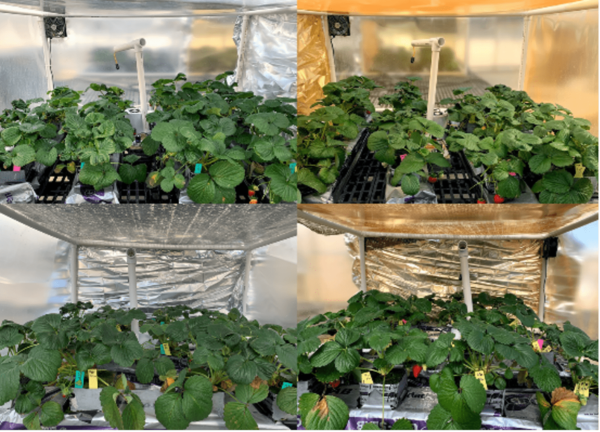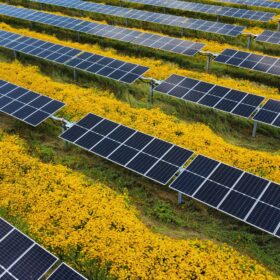It is estimated solar installations may cover more than 3 million acres of the United States over the next decade, opening the door for PV to be paired with agricultural land to produce food, conserve ecosystems, and maximize income for farmers and growers. Decarbonizing food production, which accounts for as much as 30% of global emissions, makes agrivoltaics an environmental win-win.
A new solution for controlled-environment agriculture is set to be developed in a partnership between Heliene, a solar module manufacturer, and UbiQD, a photoluminescent materials integrator. The two seek to build a solution for greenhouses that transmits useful light for the plants inside and produces solar energy.
UbiQD builds translucent panels for greenhouses that are integrated with photoluminescent particles that are efficient at converting light into a preferable wavelength. The UbiQD “UbiGro” panels glow a spectrum of color that is optimized for plant growth, absorbing UV and blue light and emitting fruitful orange or red light.

Image: UbiGro
In recent trials, UbiGro led to a 21% boost in flowering in geranium flowers, a 14-28% boost in winter strawberry growth, and an 8% yield increase in cannabis production. Increased crop yields are a welcome sign to any grower, and the two companies are set to take that benefit one step further, integrating productive solar PV in the greenhouse-topping modules.
The practice of co-locating solar energy production with food growth has been dubbed by many as “agrivoltaics.” The emerging sector taps into the benefits of localizing energy and preserving land use. In greenhouse agrivoltaics, there is a tradeoff between the transparency of the roofing and the electrical production. Herein lies the motivation to add yield boosting photoluminescence to the product.
“As energy costs continue to rise, the controlled environment agriculture industry will have to utilize energy sources more efficiently,” said Martin Pochtaruk, CEO of Heliene. “Greenhouses and photovoltaics generate hundreds of billions of dollars of value from sunlight, and our plan is that with our agrivoltaic modules, the whole will be greater than the sum of the parts.”
UbiQD has been developing electricity-generating windows alongside the photoluminescent light-optimizing UbiGro product. Now, with the participation of a major North American solar PV manufacturer in Heliene, the two can continue to develop and scale the photovoltaic element of the product.
Research by Oregon State University found that solar and agricultural co-location, including both indoor and outdoor uses, could provide 20% of the total electricity generation in the United States. Wide-scale installation of agrivoltaics could lead to an annual reduction of 330,000 tons of carbon dioxide emissions while “minimally” impacting crop yield, the researchers said.
The Oregon State paper found that an area about the size of Maryland would be needed if agrivoltaics were to meet 20% of US electricity generation. That’s about 13,000 square miles, or 1% of current U.S. farmland.
This content is protected by copyright and may not be reused. If you want to cooperate with us and would like to reuse some of our content, please contact: editors@pv-magazine.com.









By submitting this form you agree to pv magazine using your data for the purposes of publishing your comment.
Your personal data will only be disclosed or otherwise transmitted to third parties for the purposes of spam filtering or if this is necessary for technical maintenance of the website. Any other transfer to third parties will not take place unless this is justified on the basis of applicable data protection regulations or if pv magazine is legally obliged to do so.
You may revoke this consent at any time with effect for the future, in which case your personal data will be deleted immediately. Otherwise, your data will be deleted if pv magazine has processed your request or the purpose of data storage is fulfilled.
Further information on data privacy can be found in our Data Protection Policy.